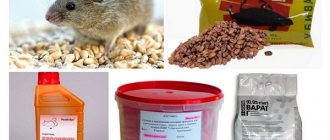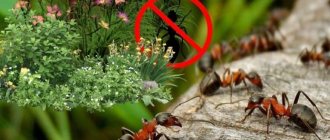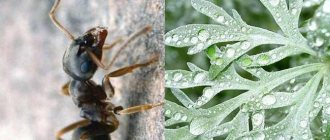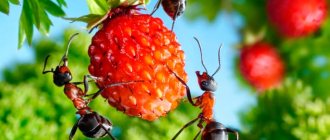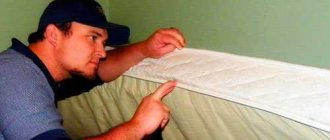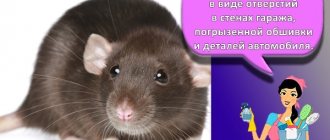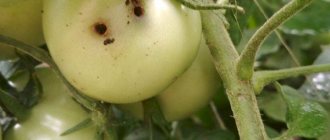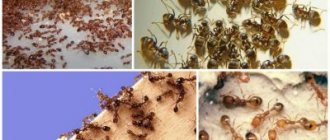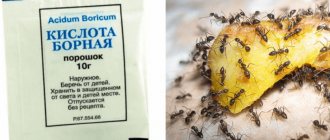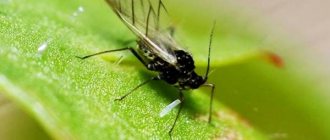The question of how to get rid of ants in the countryside worries every gardener. You can cope with the problem yourself using professional or folk remedies.
The article contains useful tips and popular methods that will help drive ants out of your summer cottage.
Ants in a summer cottage are a common problem that you can deal with yourself using folk remedies or insecticides
You cannot get rid of ants with 100% certainty: there are no guarantees, they will still come back.
Types of ants
Different types of ants are found everywhere in our country. They differ from each other not only in external signs, but also in the degree of harm caused.
Most often, the following varieties settle in the garden and vegetable garden :
- red domesticated (pharaonic, myrmica) - insects have a dark brown color and a body length of up to 6 mm;
- red wood borers - reach sizes up to 2 cm. They live in tree trunks, old stumps, and wooden houses. By building their moves, they can turn even a strong log into dust;
- black garden ants are working individuals 3-5 mm long, they settle in the root system of plants, which leads to their rapid death. They also contribute to the breeding of aphids, which adversely affects the harvest;
- red forest ants are working individuals 4-9 mm in length, and winged males are about 1 cm.
Ants feed on the sweet secretions of aphids, so in those places where there is an anthill, there will definitely be plants affected by this pest
For an ordinary summer resident (not an entomologist), it does not matter at all what kind of insects have settled on his plot, since ants of all Russian varieties bring the same harm and benefit to the plot.
Attracting Natural Enemies
To get rid of the unpleasant proximity to ants, you can add natural enemies to them. These include hedgehogs. These prickly creatures eat more than just apples and mushrooms. They are not averse to eating garden pests. Hedgehogs are omnivores and differ in the habits of predators. If you come across an anthill on the way, this creature will most likely destroy it and eat some of the inhabitants.
Harm and benefits of insects in the garden
Whether it is worth tolerating the presence of these insects on the site is a controversial issue, since on the one hand they bring certain benefits, and on the other, they cause significant harm.
Positive sides:
- destroy fleas, slugs, parasite larvae and other pests;
- loosen the soil;
- pollinate plants;
- saturate the soil with oxygen and fertilize it.
However, often the negative effects are much more noticeable than the benefits:
- carry weed seeds;
- damage berries, fruits, vegetables and flower buds;
- aphids are bred, which suck the juices from the leaves and stems, buds and buds of plants.
Most often, sweet fruits and berries suffer from ants, which attract insects with their taste and aroma.
Analyzing the benefits and harms of ants, the owner of a summer cottage independently makes a decision about the future fate of the insects. They can be left or destroyed using pesticides , and can also be repelled and driven away with folk remedies.
Questions and answers about ants
- Can goosebumps transmit infection? Yes they can. Crawling through garbage cans or compost pits in search of food, they can also carry infections on their paws. For example, helminthiasis can be “introduced” by house ants.
- Why do ants breed aphids? Aphids, as one of the main pests, constantly suck the juice from plants. They need this juice, because moisture continuously evaporates from their surface. During their life, aphids produce honeydew. It is for the sake of this moisture that ants are ready to care for aphids the same way we care for domestic animals. What do ants do? They transfer aphids to young sprouts or ripe fruits and berries, and save them from ladybugs and other insects. And with the arrival of cold weather, they transfer aphids to their anthills. The goosebumps tickle the aphids with their antennae, and for this they secrete honeydew.
- Is it possible to get rid of goosebumps using millet? You can get rid of it. Regular store-bought millet is scattered into ant tunnels. The main thing is not to skimp on the cereal. You need to sprinkle it two or three times, very generously. An average anthill will need approximately 3 kg. Ants disappear from the area. No one knows exactly why this happens, because scientific experiments have not been carried out. According to one version of folk craftsmen, ants confuse grains of millet with ant eggs. They take care of the grains, but insects do not pay attention to real eggs, and the goosebump embryos die.
- Ants are roaming around the strawberry patch in droves, but there is no anthill in sight. What is the reason, where is their home? Garden insects live in nests underground. Ants build complex labyrinths; inside the anthill they have their own system of round chambers. The entire anthill is connected by passages. And above the complex of labyrinths, intelligent goosebumps build a small mound. It is called "ant point". This mound is perfectly warmed by the sun, and the offspring of ants are actively developing in it.
- Is it possible to get rid of ants at the dacha or not? You can't get rid of these insects. They will always crawl from a neighboring plot or forest and other natural areas. It is important to keep their number under control. Then they will not harm either the garden or the vegetable garden.
We recommend studying: the best option for feeding tomatoes with boric acid from a professional
How to remove garden ants with chemicals
Let's start with the fact that you should resort to killing ants with chemical means only when the area is very neglected.
A normal gardener almost always makes do with “gentle” methods for three reasons:
- Ants are not only harmful, but also beneficial. They should not be completely destroyed at all. You can simply scare them away from those places where they greatly interfere and breed aphids.
- Many ant repellent chemicals are toxic. They can harm children, pets and beneficial insects.
- Radical removal of ants from a site is impossible in principle. No matter how you destroy them, they still come back. This means that the area will have to be “etched” constantly, and toxic substances will inevitably accumulate in the soil. No one needs such a “fight” (considering the moderate harm caused by ants).
Effective remedies against ants and brief instructions for their use:
| Active substance. Drug name | Instructions for use | Peculiarities |
| Diazonin. "Ant", "Muracid", "Anteater", "Thunder-2" | Each product is sold both in powder form and in the form of solutions of varying concentrations. The method of dilution and use is described in detail on the packaging | All are quite dangerous, although effective |
| Fenvalerate. "Phenaxin" | Easy to use (powder). Follow the instructions on the package | The effectiveness is not very high, since it only acts when it hits the body of an insect. Low toxicity |
| Chlorpyrifos. Gel preparations “Absolute”, “Great Warrior”, etc. | Follow the instructions | Chlorpyrifos is a highly toxic substance with an “accumulation effect”. When it is used spread over a smooth surface (for example, along baseboards in a home), the risk of poisoning people or pets is quite low. The problem is that it is almost impossible to apply the gel in a thin layer to the anthill and to the soil in general. It is squeezed out into “puddles”, and the likelihood that a cat or dog will get dirty in it increases many times over. Overall difficult to use and too dangerous |
To permanently destroy an anthill on a site, it is necessary to destroy the queen. This can be done with the help of poisonous baits that workers bring into their homes, infecting the rest of the “population” (preparations based on chlorpyrifos are suitable).
One of the important sources of food for ants is the waste products of aphids. Insects carry and protect it and grow it themselves, just like on a farm. Therefore, you can take measures to eliminate aphids from the area.
If aphids appear without the participation of ants, they are also destroyed (they really spoil the plants). Let's list some drugs against aphids: “Biotlin”, “Decis-Profi”, “Bi-58”, “Alatar”, “Zubr”, “Tanrek” - they are effective, but dangerous for bees.
There are folk remedies to combat aphids (read more about this in our other article).
The issue of exterminating ants should be approached comprehensively, focusing efforts on the destruction of the insects themselves and their food source - aphids
The summer resident must, in each individual case, take a reasonable approach to the use of “chemistry”, assessing such factors as the degree of infestation of the site with specific pests, the ability to cope with them using traditional or biological methods, the danger of the drugs for people, animals and beneficial insects, the likelihood of its accumulation in the soil and etc.
Methods for destroying the queen ant
The family of these insects represents a clearly organized hierarchical structure. The queen leads the colony. Its only purpose is oviposition. It significantly exceeds the size of working individuals. It has a large abdominal oviparous organ and massive chest with a well-developed muscular system. The lifespan is about 20 years, which is longer than the biological existence of any other ant.
Destruction of the queen is a key condition for getting rid of the entire family. She lives deep in the depths of the anthill and never comes to the surface. In large polygynous colonies there are two or more queens. To destroy it, the methods described above for deep influence on the anthill are suitable - from boiling water, ammonia, ammonia and borax to potent insecticides.
Attention! Removing the queen does not provide a 100% guarantee of getting rid of the ant family. In a large-scale nursery there are several of them. Before death, she may have time to lay eggs. Among the new brood, it is possible that a queen will appear, which will again begin to actively increase the number of pests.
How to get rid of ants in a summer cottage using folk remedies
Folk remedies can be considered as natural repellents that help not to destroy flying and crawling insects, but to scare them away. They have a number of significant advantages:
- availability;
- safety for humans and animals;
- no negative impact on plants;
- ease of use;
- high efficiency;
- low cost.
Herbs with strong aromas give good results.
To repel pests, you can valerian, mint, lemon balm or parsley near use substances with pungent odors - herring brine, garlic tincture, cinnamon, unrefined sunflower oil. Treat the anthill with them and, after a couple of weeks, the insects will leave the area.
There is a popular method : remove the top part of the anthill, make deep holes in the soil and pour hot (“fiery”) ash into them. (Only it’s not so much ash that acts here, but high temperature.)
Ammonia will not help in the fight against ants. In a small concentration (alcohol + water), the smell of ammonia will disappear very quickly. The ants will simply “sit out” it in the underground passages. And in higher concentrations, using ammonia solution on the beds is harmful to plants.
You can destroy an anthill using mechanical methods: pour boiling water or kerosene, cover it with ash or semolina.
Ant baits
You can gradually remove insects from the garden using homemade baits: sponges, pieces of cloth/paper soaked in a sweet solution (with the addition of honey, jam, yeast), or glass containers with syrup, from which the ants cannot escape. After a large number of goosebumps, attracted by the appetizing aroma, have accumulated, the bait should be poured with boiling water and replaced with a new one.
Poisonous baits are also effective, and they can be easily prepared yourself using one of the recommended recipes:
- Boil 3 potato tubers and 3 chicken eggs. Mash them, add 10 g of boric acid, 1 tbsp. l. sugar and vegetable oil, mix well. Roll the resulting mass into balls and place them around the anthill.
- Mix 2 tbsp. l. minced meat and 0.5 tsp. Boers. Make balls and place them along the ant paths.
- Take 1/3 tsp. borax, 2 tbsp. l. hot water and 1 tbsp. l. Sahara. Stir everything well until smooth and add 1 tsp. honey Spread the poisonous mixture around the anthill. To be effective, change the bait several times a week.
The best bait for goosebumps is sweetness. Make a trap with honey, jam or sweet syrup, and then destroy the insects caught in it
How to fight in the garden?
The extermination of females, males and eggs is carried out in a comprehensive manner. Ants love quiet places, so they colonize the soil where areas are cultivated less frequently. An important rule is to frequently dig up the soil or loosen it. Thus, there will be less chance of strengthening the ant house.
Trees are treated with a strong, saturated lime solution. This applies to the trunks, the exposed root system and the surrounding area. If you find one or more nests or small anthills, you need to destroy it. Using a shovel, dig the nest and adjacent soil deeper and fill it with lime. It is also recommended to cover the top with ash or ashes. The final stage is to re-dig the soil.
Prevention of ants
To prevent the appearance and reproduction of insects in your summer cottage, follow the following preventive measures:
- plant aromatic plants - mint, garlic, wormwood, etc.;
- destroy insects in a timely manner as soon as you find them on the site, preventing active reproduction and rapid population growth.
When choosing means of control and prevention, consider not only their effectiveness, but also their safety for humans, animals and cultivated plants.
Ant
The main active ingredient of this insecticide is diazinon. The drug acts as a food bait (it looks like granules). The pellets are eaten by ants, and then the process of paralysis begins. Some of the pesticides remain on the parasites' paws, so when they get into the nest, other relatives are also infected. As a result of the Ant's action, the complete destruction of the population is possible.
